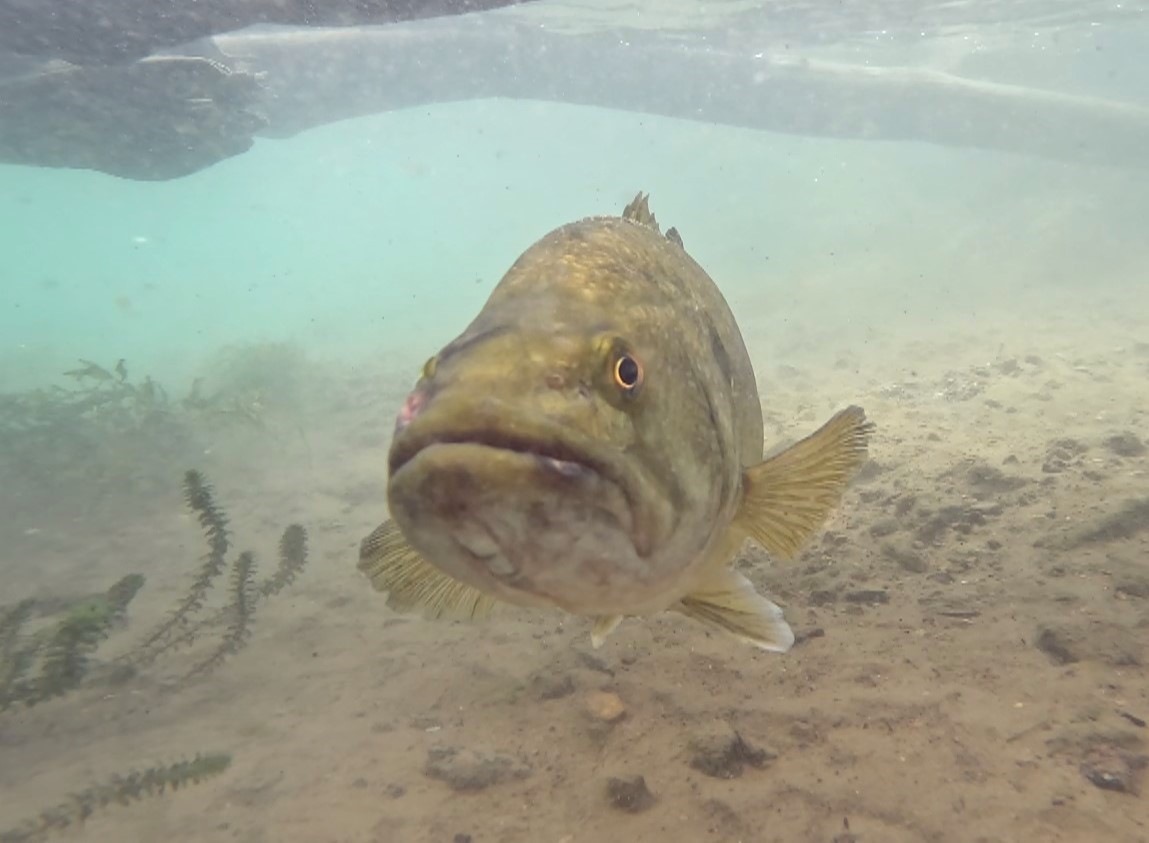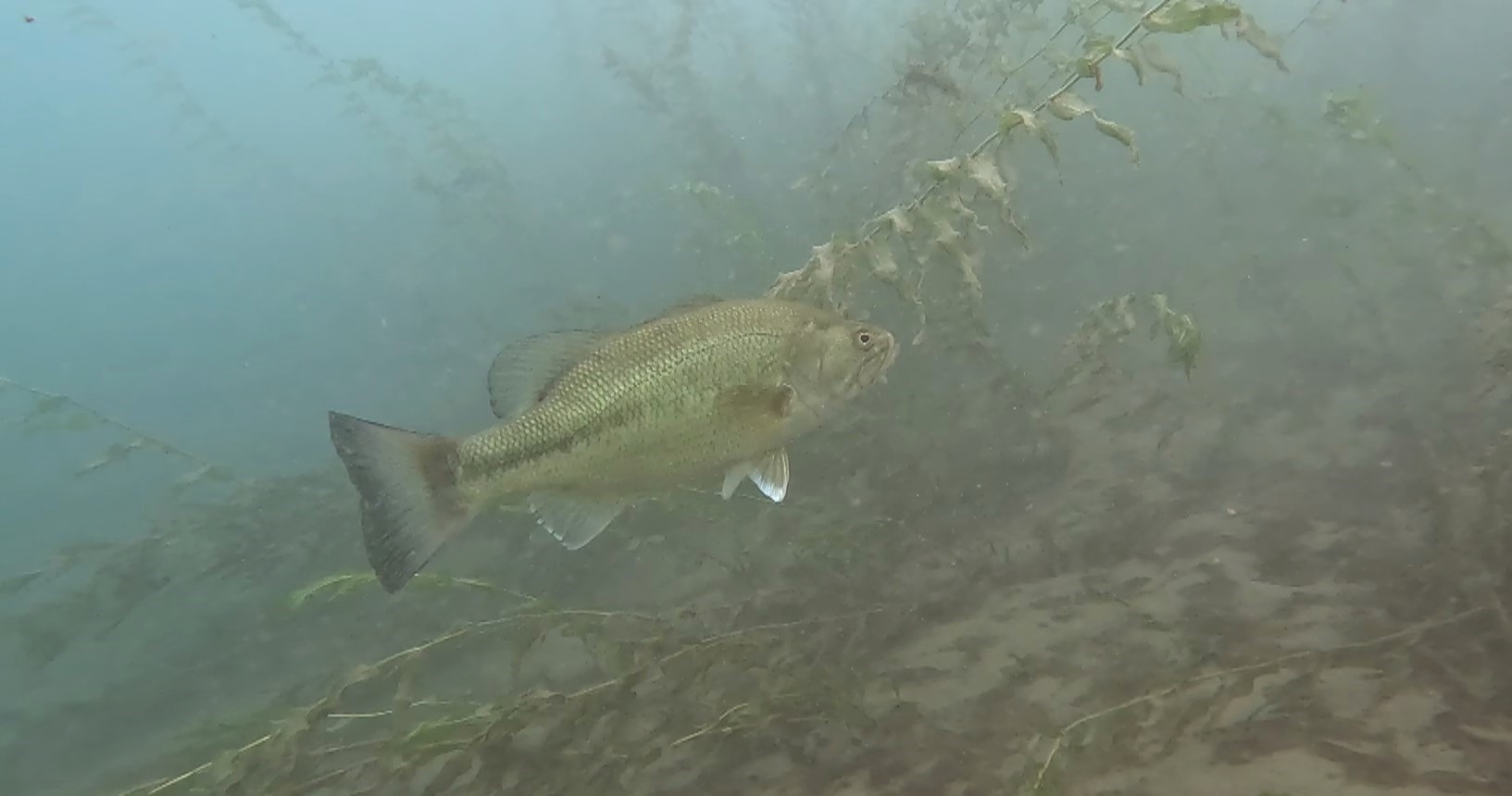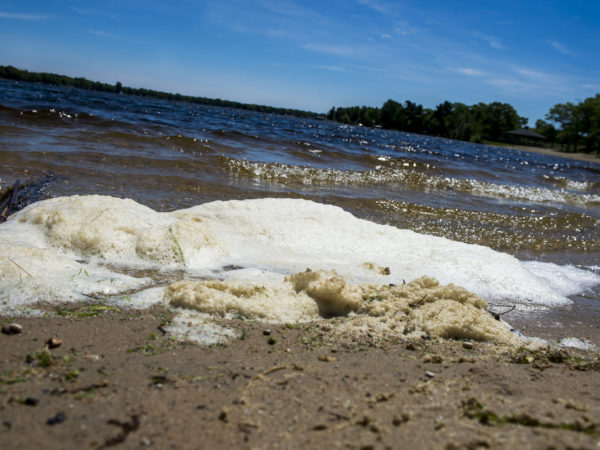
 I Speak for the Fish is a monthly column written by Great Lakes Now Contributor Kathy Johnson, coming out the third Monday of each month. Publishing the author’s views and assertions does not represent endorsement by Great Lakes Now or Detroit Public Television. Check out her previous columns.
I Speak for the Fish is a monthly column written by Great Lakes Now Contributor Kathy Johnson, coming out the third Monday of each month. Publishing the author’s views and assertions does not represent endorsement by Great Lakes Now or Detroit Public Television. Check out her previous columns.
I planned to cover rock bass, smallmouth and largemouth, respectively, before finishing my bass series with white bass. That was the plan but that is not how it worked out.
Over the years, I’ve had many enjoyable dives with rock and smallmouth bass and spent hours watching white bass on our underwater livestream. But the largemouth proved to be my weak point.
I never see them in the fast-flowing waters of the upper St. Clair River, where I do most of my diving. To film a largemouth for this column, I needed to visit sites with slower-moving water and lots of vegetation.
My quest to find and document a largemouth took almost two months, forcing me to change the intended order of my bass series.
I’m guessing there are lots of researchers and anglers out there who can sympathize with my struggle to find a specific fish species on demand.
When I did find one, it was a fleeting encounter.
Big Mouths

A largemouth bass will eat almost anything it can catch. (Photo Credit: Greg Lashbrook/PolkaDot Perch)
Although smallmouth and largemouth share many physical characteristics, they have very different temperaments, and their paths rarely cross, even though they often live in the same bodies of water.
In my previous column, I suggested smallmouths were like 3-year-old German shepherd guard dogs. By the same standards, largemouth are like 8-year-old English bulldogs: equally fearsome guardians with a more aloof demeanor and a preference for a quieter lifestyle.
For years, I thought largemouth were bigger and tougher than smallmouth. This assessment was based purely on their names. When I hear large and small, I immediately think the advantage goes to the large side. While that may follow in some instances it was a terribly misguided thought process in this case.
For this bass, large and small simply refers to where their mouths end in relation to their eyes. If you were to draw a line through their eyes and down their face, a smallie’s mouth would end just before the line while a largemouth’s would extend slightly past the eye line.
Largemouth bass are the largest members of the Centrarchidae sunfish family and its black bass subgroup.
The average size of largemouth bass in the Great Lakes is just under 12 inches, which is not particularly large. They reach larger sizes in the southern United States, where they can grow year-round. Great Lakes fish do not eat as much in the winter months, and therefore do not grow as large as southern largemouth.
Their back and sides are a blotchy blend of greens from olive to forest. Their bellies are creamy white. A distinguishing dark stripe begins near their eye and runs along the side of their bodies to their tails. The stripe is more pronounced in juveniles and often fades as they age.
Largemouth are the epitome of opportunistic feeders.
Between three field guides the list of what a largemouth will eat includes all manner of small fish from emerald shiners to gizzard shad, and bluegill to bullhead catfish. Apparently, they will take anything they can catch including crayfish, frogs, snakes, salamanders, mice, muskrats, and ducks.
Largemouth are ambush predators. They wait in grass beds for unsuspecting prey to pass too closely. However, they will also pursue fish into open water if necessary. The slightly larger size of their mouths allows them to take bigger prey than a smallmouth might attempt.
Big Nests

Largemouth bass use logs and branches for shelter and cover. (Photo Credit: Greg Lashbrook/PolkaDot Perch)
Nest building and guarding are two key behaviors contributing to largemouth falling on the sunfish side of the family tree.
Largemouth spawn in the spring and early summer. They make nests on the bottom just like bluegill, but the largemouth nests are supersized in comparison. The circular beds can reach up to 3 feet in diameter and be 8 inches or more deep.
They select shallow-water sites with loose sand or soft sediment bottoms surrounded by thick vegetation. If there is a log, dock, or other structure nearby, all the better.
Males become very aggressive as they claim territories and build their nests. While males will congregate in the same area, the individual nests are usually a good 30 feet or more apart.
Largemouth males attract females with a courtship display that includes nipping and rubbing.Spawning occurs while the pair circles the nest with the female lying slightly on her side next to the male. Typically, the female will be driven from the nest before she is spent, and she will move to another nest to finish — this supports a higher degree of genetic diversity.
When the male is spent, he will remain in the nest to guard the eggs from predators. He will also keep the eggs well aerated by fanning them with his fins.
Occasionally, other fish species, like lake chub suckers, may sneak in and deposit their eggs in the largemouth’s nest. The offspring of these “sneakers” will then benefit from the largemouth bass’s excellent paternal care.
After the fry hatch and absorb their yolk sacks, they will come together to form a tight ball. Then, the translucent gray ball swirls around the bottom of the nest like a whiff of smoke from an extinguished candle.
The male will continue to protect the fry ball until the school has dispersed, which can take up to a month.
Big Range

Largemouth are tolerant of warm water temperatures and like to live in the weeds. (Photo Credit: Greg Lashbrook/PolkaDot Perch)
Theoretically, locating a largemouth in the Great Lakes should be easy since they are endemic to the region. Their native range included the eastern half of the United States, the Great Lakes, and southern portions of Ontario and Quebec.
European settlers prized largemouth bass so much that beginning in the late 1800s their range expanded into every state except Alaska. They have also been stocked in countries throughout Europe, Asia, Africa, South America, Central America, and the Caribbean.
To locate a largemouth, I needed to leave the fast-flowing waters of the upper St. Clair River and head downstream toward the slower-moving water and dense vegetation or “seaweed” beds surrounding Lake St. Clair.
Given their preference for quiet water, it’s not surprising that largemouth are very temperature tolerant. While 70 degrees is ideal, they can handle temps as high as 90 degrees and as low as the frigid 30s. This ability may serve them well as lake temperatures continue to rise.
While largemouth are known to prefer weedy parts of lakes and rivers, their tolerance for warm water makes them highly adaptable to many environments. Again, the list I compiled from all my field guides includes almost every type of water body (except, perhaps, puddles).
Largemouth can be found in ponds, sluggish rivers, streams, creeks, brooks, ditches, slews, canals, reservoirs, lakes, inlets, and bays. But not always in the weedy parts.
A fellow diver’s favorite spot to film largemouth is in a drainage pipe at the Pinery Provincial Park in Ontario.
Thankfully, my husband and I only had to travel 30 miles downstream to find a nice quiet grass bed with a resident largemouth.
He was about as welcoming as a bulldog awakened from a nap. It was clear that he did not appreciate our intrusion into his space. Rather than attack, he simply turned away and vanished into the grass bed like a dog into a cornfield.
Our successive dives proved more successful. The old dog still had no interest in being friends but thankfully, he stuck around just long enough for us to film him so I could complete my bass series.
Overall, bass are among my favorite groups of fish.
Rock bass are like cute, playful pups. Smallmouths are like scary-smart shepherds. Largemouth are like disgruntled boxers. And, as the only true bass, white are the wolves.
Catch more news at Great Lakes Now:
I Speak For The Fish: Are muskies still the readers’ favorite?
I Speak for the Fish: Never underestimate a smallmouth
Featured image: Largemouth are more solitary than smallmouth. (Photo Credit: Greg Lashbrook/PolkaDot Perch)




